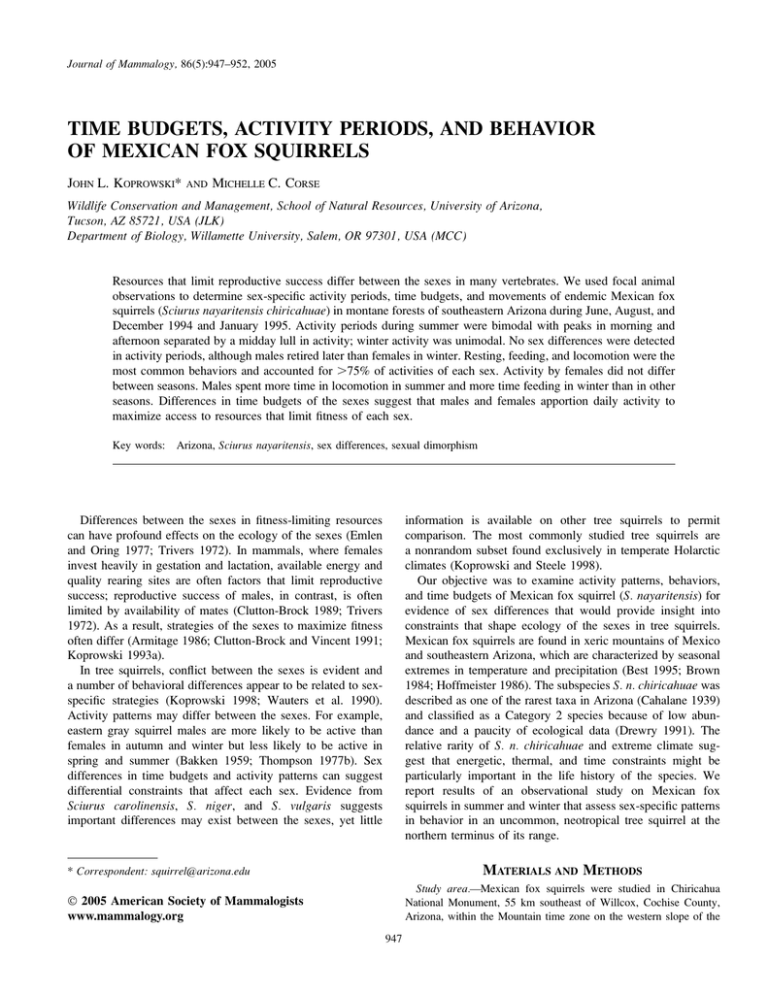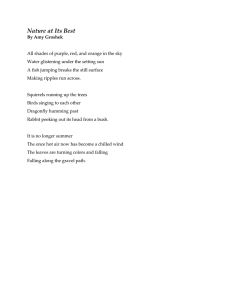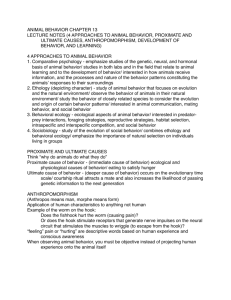TIME BUDGETS, ACTIVITY PERIODS, AND BEHAVIOR OF MEXICAN FOX SQUIRRELS J L. K
advertisement

Journal of Mammalogy, 86(5):947–952, 2005 TIME BUDGETS, ACTIVITY PERIODS, AND BEHAVIOR OF MEXICAN FOX SQUIRRELS JOHN L. KOPROWSKI* AND MICHELLE C. CORSE Wildlife Conservation and Management, School of Natural Resources, University of Arizona, Tucson, AZ 85721, USA (JLK) Department of Biology, Willamette University, Salem, OR 97301, USA (MCC) Resources that limit reproductive success differ between the sexes in many vertebrates. We used focal animal observations to determine sex-specific activity periods, time budgets, and movements of endemic Mexican fox squirrels (Sciurus nayaritensis chiricahuae) in montane forests of southeastern Arizona during June, August, and December 1994 and January 1995. Activity periods during summer were bimodal with peaks in morning and afternoon separated by a midday lull in activity; winter activity was unimodal. No sex differences were detected in activity periods, although males retired later than females in winter. Resting, feeding, and locomotion were the most common behaviors and accounted for .75% of activities of each sex. Activity by females did not differ between seasons. Males spent more time in locomotion in summer and more time feeding in winter than in other seasons. Differences in time budgets of the sexes suggest that males and females apportion daily activity to maximize access to resources that limit fitness of each sex. Key words: Arizona, Sciurus nayaritensis, sex differences, sexual dimorphism information is available on other tree squirrels to permit comparison. The most commonly studied tree squirrels are a nonrandom subset found exclusively in temperate Holarctic climates (Koprowski and Steele 1998). Our objective was to examine activity patterns, behaviors, and time budgets of Mexican fox squirrel (S. nayaritensis) for evidence of sex differences that would provide insight into constraints that shape ecology of the sexes in tree squirrels. Mexican fox squirrels are found in xeric mountains of Mexico and southeastern Arizona, which are characterized by seasonal extremes in temperature and precipitation (Best 1995; Brown 1984; Hoffmeister 1986). The subspecies S. n. chiricahuae was described as one of the rarest taxa in Arizona (Cahalane 1939) and classified as a Category 2 species because of low abundance and a paucity of ecological data (Drewry 1991). The relative rarity of S. n. chiricahuae and extreme climate suggest that energetic, thermal, and time constraints might be particularly important in the life history of the species. We report results of an observational study on Mexican fox squirrels in summer and winter that assess sex-specific patterns in behavior in an uncommon, neotropical tree squirrel at the northern terminus of its range. Differences between the sexes in fitness-limiting resources can have profound effects on the ecology of the sexes (Emlen and Oring 1977; Trivers 1972). In mammals, where females invest heavily in gestation and lactation, available energy and quality rearing sites are often factors that limit reproductive success; reproductive success of males, in contrast, is often limited by availability of mates (Clutton-Brock 1989; Trivers 1972). As a result, strategies of the sexes to maximize fitness often differ (Armitage 1986; Clutton-Brock and Vincent 1991; Koprowski 1993a). In tree squirrels, conflict between the sexes is evident and a number of behavioral differences appear to be related to sexspecific strategies (Koprowski 1998; Wauters et al. 1990). Activity patterns may differ between the sexes. For example, eastern gray squirrel males are more likely to be active than females in autumn and winter but less likely to be active in spring and summer (Bakken 1959; Thompson 1977b). Sex differences in time budgets and activity patterns can suggest differential constraints that affect each sex. Evidence from Sciurus carolinensis, S. niger, and S. vulgaris suggests important differences may exist between the sexes, yet little MATERIALS AND METHODS * Correspondent: squirrel@arizona.edu Study area.—Mexican fox squirrels were studied in Chiricahua National Monument, 55 km southeast of Willcox, Cochise County, Arizona, within the Mountain time zone on the western slope of the Ó 2005 American Society of Mammalogists www.mammalogy.org 947 948 Vol. 86, No. 5 JOURNAL OF MAMMALOGY Chiricahua Mountains in June, August, and December 1994 and January 1995. Late May through early July are typically without precipitation (dry summer) and late July through September are dominated by wet monsoonal rains (wet summer). Fieldwork was conducted in Bonita and Rhyolite canyons, which are dominated by 5 species of oaks (Quercus), 3 species of pines (Pinus), alligator juniper (Juniperus deppeana), and Arizona cypress (Cupressus arizonica— Kneeland et al. 1995). Observational techniques.—Each evening we searched for squirrels, determined their sex by visual inspection of external genitalia with the aid of binoculars, and followed individuals to their nest; we observed behaviors of these focal animals over the subsequent day from morning nest exit to evening nest entrance. We conducted focal animal observations (Altmann 1974) to record behaviors with aid of binoculars at 1-min intervals. Observation periods were in the dry summer before monsoonal rains (June: male, 5,633 min, n ¼ 12 individuals; female, 7,328 min, n ¼ 16 individuals), wet summer during monsoonal rains (August: male, 5,454 min, n ¼ 9 individuals; female, 4,122 min, n ¼ 9 individuals), and winter (December–January: male, 1,831 min, n ¼ 8 individuals; female, 3,667 min, n ¼ 9 individuals). S. nayaritensis appears to produce only a single litter each year (Best 1995; Pasch and Koprowski, in press), with young emerging from late May through August at our study site (Pasch and Koprowski, in press) and males with scrotal testes following females through early August. June and August observations were conducted during the breeding season, whereas December–January observations occurred before the breeding season. Mexican fox squirrels are remarkably tolerant of human presence (Cahalane 1939; Kneeland et al. 1995), enabling us to follow individuals at a distance of approximately 20 m. The low levels of vigilance by squirrels that we observed (1.1–3.2% of daily time budget) further supported this characterization. As animals moved through the forest, occasionally we were unable to see behaviors for short periods of time; however, we only included individuals in analyses if we were able to follow their behaviors during .85% of the minutes of daylight. Because observations were conducted throughout an entire day for each animal, our observational efforts were distributed evenly throughout the day. In addition, we only used each animal once in a season. However, because of relative rarity and our difficulty in trapping and marking animals, some individuals were likely represented in more than 1 season. Individuals were unmarked because of difficulty in capturing animals; however, we used external genitalia, unique molting patterns, and nest site location to minimize potential of animals being represented more than once in our observations within a season. We classified behaviors as locomote (run, walk, hop, and climb with head raised above longitudinal body plane), feed (foraging, actively ingesting food or drink, or processing food items), vigilant (head raised, apparently to survey surroundings), rest (remaining motionless on substrate or within nest), groom (autogrooming of pelage), scent marking (rubbing of oral and cheek glands upon substrate, after Koprowski 1993b), and social (amicable and agonistic interactions between individuals). In dry summer, we also visually estimated distance moved between successive 1-min observations. Parameter estimation and analysis.—We calculated time of activity by determining proportion of time that each individual was active (not resting) in each hour of observation. Daily activity patterns of males and females were compared for each hour by Mann–Whitney U-tests. Nest entrance and exit times were converted to minutes past sunrise and compared by t-tests; sample sizes for nest entrance and exit times differ from focal observational data because we included ad libitum sampling of observations of nest entrances and exits in addition to animals that we excluded from other analyses because we were not able to observe .15% of their time out of nest. We calculated time budgets for each animal by summing occurrences of a behavior across hours within a day and dividing by total minutes of observation. Proportion of time spent in each behavior was compared between seasons (Kruskal–Wallis tests) and sexes (Mann–Whitney U-tests). Distance moved between each successive minute was summed over the entire day for each animal to estimate movement only during the dry summer. Snowmelt in ephemeral streams in winter and monsoonal rains in wet summer made such estimation difficult for researchers trying to follow squirrels and negotiate water flows. We compared daily distance traveled between the sexes by using Mann–Whitney U-tests. Mean (6 1 SD) values are presented in the text; P values , 0.10 are considered to indicate potential biological significance for this uncommon species. Our methods followed the guidelines of the American Society of Mammalogists (Animal Care and Use Committee 1998). RESULTS Activity periods.— In dry and wet summer seasons, diel activity of S. nayaritensis followed a bimodal distribution. Mexican fox squirrels became active with sunrise and activity peaked during early morning (Fig. 1). The morning peak in activity was followed by an early- to midafternoon lull of 2–3 h. A 2nd daily peak in activity occurred in late afternoon. In winter, activity was generally unimodal with high levels of activity throughout the day (Fig. 1). Activity time (expressed as a proportion of the hour that individuals were active) was similar between the sexes for each hour in dry summer (all P . 0.31, n ¼ 16, 12) and winter (all P . 0.16, n ¼ 9, 8). During wet summer, only slightly higher activity of females at 1600 h approached significance (W ¼ 31.0, P , 0.07, n ¼ 9, 9; all other P . 0.16). Males and females entered and exited nests at similar times throughout summer. In dry summer, males and females exited in early morning (0536 h 6 32.8 min and 0613 h 6 70.0 min, respectively; t ¼ 1.41, d.f. ¼ 11, P ¼ 0.19) and returned to the nest in late evening (1838 h 6 50.6 min and 1802 h 6 135.0 min, respectively; t ¼ 0.76, d.f. ¼ 10, P ¼ 0.46). Duration of time between morning nest exit and evening nest entrance was similar for males and females in dry summer (713 min 6 93 SD and 690 6 185 min, respectively; t ¼ 0.28, d.f. ¼ 7, P ¼ 0.79). In winter, males exited nests at times (0916 h 6 165 min) similar to females (0810 h 6 21.0 min; t ¼ 1.04, d.f. ¼ 6, P ¼ 0.34). However, males remained active until later in the day than females (1558 h 6 46.6 min versus 1432 h 6 27.2 min; t ¼ 4.43, d.f. ¼ 11, P ¼ 0.001). Duration of time between morning nest exit and evening nest entrance was similar for males and females in winter (370 6 100 min and 314 6 109 min, respectively; t ¼ 0.89, d.f. ¼ 9, P ¼ 0.40). Time budgets.— Mexican fox squirrels of both sexes spent the majority of each day (.78%) resting or procuring food during dry summer, wet summer, and winter (Fig. 2). Locomotion also consumed a substantial portion (.8%) of the daily time budget. All other behaviors were uncommon; vigilance never averaged .4% of the time budget during any season for either sex (male: dry summer, 3.1% 6 7.0%; wet October 2005 KOPROWSKI AND CORSE—ACTIVITY IN MEXICAN FOX SQUIRRELS 949 FIG. 1.—Activity patterns of adult female and male Mexican fox squirrels (Sciurus nayaritensis chiricahuae) in a) dry summer (n ¼ 16 females, 12 males; sunrise ¼ 0516 h, sunset ¼ 1931 h), b) wet summer (n ¼ 9, 9; sunrise ¼ 0544 h, sunset ¼ 1913 h), and c) winter (n ¼ 9, 8; sunrise ¼ 0725 h, sunset ¼ 1732 h). FIG. 2.—Time budgets of adult female and male Mexican fox squirrels (Sciurus nayaritensis chiricahuae) in a) dry summer (n ¼ 16 females, 12 males), b) wet summer (n ¼ 9, 9), and c) winter (n ¼ 9, 8). summer, 1.1% 6 1.3%; winter, 3.2% 6 5.9%; female: dry summer, 1.8% 6 1.9%; wet summer, 1.5% 6 1.1%; winter, 1.4% 6 2.2%), whereas scent marking (,0.4% of daily time budgets), autogrooming (,1.6% of daily time budgets), and social interactions (,0.9% of daily time budgets) were less common. Scent marking was uncommon (n ¼ 17), occurred at dispersed locations along small limbs in the canopy, and was not sex biased (v2 ¼ 0.32, d.f. ¼ 1, P . 0.30 when using an expected male : female ratio of 0.46 : 0.54 based upon minutes of observation of each sex). Social interactions in general were limited and consisted primarily of agonistic chases. Amicable interactions were only observed 5 times and 4 of these consisted of adult females at play with their juveniles. On one occasion, we observed 2 adult males with scrotal testes to groom and play. In addition, communal nesting was observed 950 JOURNAL OF MAMMALOGY between 2 adult males with scrotal testes on 2 of 41 nesting events (15 males, 21 females, and 5 unknown) during wet summer. Communal nests were more common in winter, when we located 3 nesting groups that remained intact for at least 21 days as judged by consistency in number and sex of group members. Eight of 31 squirrels (12 males and 19 females) for which we recorded a nest entrance in winter involved communal groups. Two groups consisted of adults of both sexes (1 male with 1 female, and 1 male with 2 females) and a 3rd group was composed solely of 4 adult females and 2 subadult females. We never observed any additional amicable or agonistic behavior at nests. Time budgets for female Mexican fox squirrels were similar between dry summer, wet summer, and winter (Fig. 2). Feeding (Kruskal–Wallis H ¼ 0.75, d.f. ¼ 2, P ¼ 0.69), locomotion (H ¼ 2.45, d.f. ¼ 2, P ¼ 0.29), and resting (H ¼ 0.81, d.f. ¼ 2, P ¼ 0.67) were similar in frequency over seasons. In contrast, feeding by males (Fig. 2; H ¼ 4.90, d.f. ¼ 2, P ¼ 0.09) peaked in winter, locomotion (H ¼ 5.29, d.f. ¼ 2, P ¼ 0.07) was greatest in dry summer, and resting did not show a strong seasonal effect (H ¼ 3.44, d.f. ¼ 2, P ¼ 0.18). None of 4 uncommon activities (vigilance, scent mark, groom, or social interaction) varied across seasons in males or females (Kruskal–Wallis, d.f. ¼ 2, all P . 0.30). Within any season, uncommon behaviors (vigilance, scent mark, groom, or social interaction) did not differ in frequency between the sexes (Mann–Whitney U-tests, P . 0.20). In dry summer, males spent more time in locomotion than did females (W ¼ 186.0, P ¼ 0.04, n ¼ 16, 12); feeding (W ¼ 223.5, P ¼ 0.71, n ¼ 16, 12) and resting (W ¼ 255.0, P ¼ 0.30, n ¼ 16, 12) did not differ between sexes. Time budgets did not differ between sexes in wet summer (feeding: W ¼ 86.0, P ¼ 0.99, n ¼ 9, 9; locomotion: W ¼ 80.0, P ¼ 0.66, n ¼ 9, 9; resting: W ¼ 82.5, P ¼ 0.83, n ¼ 9, 9). In winter, females rested more than did males (W ¼ 99.5, P ¼ 0.08, n ¼ 9, 8), whereas males fed nearly twice as often as did females (W ¼ 61.0, P ¼ 0.06, n ¼ 9, 8); time spent in locomotion did not differ between the sexes (W ¼ 82.0, P ¼ 0.96, n ¼ 9, 8). Daily distance traveled.— Male Mexican fox squirrels moved greater daily distances (1.37 6 0.50 km, range ¼ 0.79–2.44 km) than did females (0.97 6 0.47 km, range ¼ 0.24–1.87 km; W ¼ 124.0, P ¼ 0.05, n ¼ 16, 12) in summer. DISCUSSION Activity patterns of Mexican fox squirrels are congruent with those of other tree squirrels; activity is bimodal through the warmest and longest days and shifts toward a unimodal pattern in winter (S. carolinensis—Bakken 1959; Thompson 1977b; S. niger—Adams 1984; Geeslin 1970; Hicks 1949; Hilliard 1979; S. vulgaris—Wauters et al. 1995b). However, no sex differences in diel activity patterns were evident for Mexican fox squirrels, in contrast to eastern gray squirrels (Bakken 1959; Thompson 1977b). Activity levels of Mexican fox squirrels appear to be generally high for both sexes relative to eastern gray squirrels (Gurnell 1987) but similar to Eurasian red squirrels (S. vulgaris—Wauters et al. 1995b) and do not Vol. 86, No. 5 demonstrate significant sex differences despite seasonal changes in activity. Time allocated by Mexican fox squirrels to different behaviors generally is similar to that of other tree squirrels (Erossy 1973; Gurnell 1987; Hampshire 1985; Jodice and Humphrey 1992; Wauters et al. 1995b). Feeding or foraging, locomotion, and resting account for most of the time that tree squirrels are active. Time spent in locomotion is similar to other species (Wauters et al. 1995b), whereas frequency of foraging and resting behaviors differ. Eastern gray squirrels (Erossy 1973; Gurnell 1987; Hampshire 1985) and Eurasian red squirrels (Wauters et al. 1995b) usually spend .70% of active time foraging and feeding and ,10% at rest. Big Cypress fox squirrels (S. niger avicennia) spend .40% of active time foraging (Jodice and Humphrey 1992). Mexican fox squirrels spend ,45% of a day foraging or feeding (except for males during winter, which spend nearly 60% of a day foraging) and rest for considerable time (.20%) during all seasons including winter. A major constraint on time budgets of tree squirrels may be gut capacity, which results in the necessity to cease energy intake for a refractory period that permits digestion (Wauters et al. 1995b). However, male Mexican fox squirrels continue feeding for longer periods in winter than do females despite absence of sexual dimorphism in body size (Hoffmeister 1986), suggesting that gut capacity is not the most influential factor. Thermal environment can have a strong influence on location and behavior of tree squirrels (Byman et al. 1988; Golightly and Ohmart 1978; Pulliainen 1973; Tonkin 1983). Forests inhabited by Mexican fox squirrels are open and arid with high sun exposure in summer and high wind exposure in winter, which may require extended periods of rest to avoid thermal stress. Throughout summer, rest occurs on a shaded branch with the tail raised and hairs at tail base depressed in an apparent effort to shed heat via a concentration of vascular bundles (Muchlinski and Shump 1979; Thorington 1966). Rest in winter is often spent in the nest, which can result in body temperatures 308C greater than ambient (Havera 1979; Pulliainen 1973). Thermal constraints in arid montane environments of Mexican fox squirrels may explain time-budget differences with tree squirrels in more temperate coniferous and deciduous habitats. Sociality in tree squirrels typically involves sex-biased scent marking, amicable interactions, and group nesting (Koprowski 1998). Mexican fox squirrels do not appear to exhibit sex differences in social behavior; interactions are rare and scentmarking activities are not sex biased as in eastern gray and fox squirrels (Koprowski 1993b). Communal nesting does occur but appears uncommon relative to the most social of tree squirrels. Furthermore, allogrooming and adult social play at the nest that define sociality among tree squirrels (Koprowski 1996, 1998) have not been observed. A female–female bond, the fundamental unit of sciurid social systems (Armitage 1981; Michener 1983), was evident in 3 of 4 communal nesting associations, which is uncommon among asocial tree squirrels (Koprowski 1996, 1998). Our observations suggest there is some basic level of social complexity within Mexican fox squirrels despite low densities (Brown 1984; Cahalane 1939). Perhaps low densities mask or prevent formation of groups. October 2005 KOPROWSKI AND CORSE—ACTIVITY IN MEXICAN FOX SQUIRRELS Sex differences were evident in time budgets both within and between seasons for Mexican fox squirrels. Lack of seasonality in time budgets of females suggests that females are consistent in daily activities and focus heavily on food acquisition, which is a task directly related to female fitness in S. vulgaris (Wauters and Dhondt 1995; Wauters et al. 1995a). Availability of food (Barkalow et al. 1970; Koprowski 1991; Wauters and Dhondt 1995; Weigl et al. 1989), foraging success (Wauters et al. 1995a), and quality of home range (Wauters and Dhondt 1995) are directly related to reproductive success of females in some tree squirrels. However, male Mexican fox squirrels do demonstrate seasonality in time budgets. Male Mexican fox squirrels spend more than twice as much time as females in food acquisition during winter. This foraging is likely in preparation for the breeding season (Best 1995), when male tree squirrels increase home-range size (Benson 1980; Kenward 1985), participate in high levels of aggressive interactions (reviewed by Koprowski 1998), and reduce feeding (Koprowski 1994a, 1994b). During dry summer, male Mexican fox squirrels travel considerably greater distances and spend more time in locomotion than do females. The difference in locomotion is likely due to matesearching behavior (Kenward 1985; Koprowski 1998; Thompson 1977a) for females that are asynchronous in estrus (Koprowski 1993a, 1993c) and dispersed (Havera and Nixon 1978; Kenward 1985; Wauters and Dhondt 1995). Time budgets of males appear to reflect the importance to males of monitoring females as a seasonally available, fitness-limiting resource. Time budgets of females suggest an emphasis on acquisition of less mobile and spatiotemporally variable resources such as quality dens and food. ACKNOWLEDGMENTS We thank M. Kneeland, N. Michel, A. Baty, T. Cervenak, S. Hayden, N. Koprowski, Z. Koprowski, C. Kruse, E. Riggs, and A. Whalon for assistance with various aspects of fieldwork. Thorough and thoughtful efforts of 2 anonymous reviewers significantly improved the quality of the manuscript. The National Geographic Society, Southwest Parks and Monuments Association, Chiricahua National Monument, Withnell Dodge, Willamette University (Atkinson Fund and Carson Undergraduate Research Grants), and the Arizona Agricultural Experiment Station graciously provided financial and in-kind support. The Department of Zoology and Tropical Ecology at James Cook University, Townsville, Queensland, Australia, provided refuge and hospitality for JLK during data analyses. The University of Arizona supported completion of the manuscript. LITERATURE CITED ADAMS, C. E. 1984. Diversity in fox squirrel spatial relationships and activity rhythms. Texas Journal of Science 36:197–205. ALTMANN, J. 1974. Observational study of behavior: sampling methods. Behaviour 49:227–267. ANIMAL CARE AND USE COMMITTEE. 1998. Guidelines for the capture, handling, and care of mammals as approved by the American Society of Mammalogists. Journal of Mammalogy 79:1416–1431. ARMITAGE, K. B. 1981. Sociality as a life history tactic of ground squirrels. Oecologia 48:36–49. 951 ARMITAGE, K. B. 1986. Marmot polygyny revisited: determinants of male and female reproductive strategies. Pp. 303–331 in Ecological aspects of social evolution (D. I. Rubenstein and R. W. Wrangham, eds.). Princeton University Press, Princeton, New Jersey. BAKKEN, A. 1959. Behavior of gray squirrels. Proceedings of the Southeastern Game and Fish Commissioners 13:393–406. BARKALOW, F. S, JR., R. B. HAMILTON, AND R. F. SOOTS, JR. 1970. The vital statistics of an unexploited gray squirrel population. Journal of Wildlife Management 34:489–500. BENSON, B. N. 1980. Dominance relationships, mating behaviour and scent marking in fox squirrels (Sciurus niger). Mammalia 44: 143–160. BEST, T. L. 1995. Sciurus nayaritensis. Mammalian Species 492:1–5. BROWN, D. E. 1984. Arizona’s tree squirrels. Arizona Game and Fish Department, Phoenix. BYMAN, D., D. B. HAY, AND G. S. BAKKEN. 1988. Energetic costs of the winter arboreal microclimate: the gray squirrel in a tree. International Journal of Biometeorology 32:112–122. CAHALANE, V. H. 1939. Mammals of the Chiricahua Mountains, Cochise County, Arizona. Journal of Mammalogy 20:418–440. CLUTTON-BROCK, T. H. 1989. Mammalian mating systems. Proceedings of the Royal Society of London, B. Biological Sciences 236: 339–372. CLUTTON-BROCK, T. H., AND A. C. J. VINCENT. 1991. Sexual selection and potential reproductive rates of males and females. Nature 351: 58–60. DREWRY, G. 1991. Endangered and threatened wildlife and plants; animal candidate review for listing as endangered or threatened species. Federal Register 56:58804–58836. EMLEN, S. T., AND L. W. ORING. 1977. Ecology, sexual selection and the evolution of mating systems. Science 197:215–223. EROSSY, P. J. 1973. Home range and social organization of a freeranging population of gray squirrels (Sciurus carolinensis). M.S. thesis, Bowling Green State University, Bowling Green, Ohio. GEESLIN, H. G., JR. 1970. A radio-tracking study of home range, movements, and habitat uses of the fox squirrel (Sciurus niger) in east Texas. M.S. thesis, Texas A&M University, College Station. GOLIGHTLY, R. T., JR., AND R. D. OHMART. 1978. Heterothermy in free ranging Abert’s squirrels (Sciurus aberti). Ecology 59:897–909. GURNELL, J. 1987. The natural history of squirrels. Facts on File, New York. HAMPSHIRE, R. J. 1985. A study on the social and reproductive behaviour of captive grey squirrels (Sciurus carolinensis). Ph.D. dissertation, University of Reading, Reading, United Kingdom. HAVERA, S. P. 1979. Temperature variation in a fox squirrel nest box. Journal of Wildlife Management 43:251–253. HAVERA, S. P., AND C. M. NIXON. 1978. Interaction among adult female fox squirrels during their winter breeding season. Transactions of the Illinois Academy of Sciences 71:24–38. HICKS, E. A. 1949. Ecological factors affecting the activity of the western fox squirrel, Sciurus niger rufiventer (Geoffroy). Ecological Monographs 19:287–302. HILLIARD, T. H. 1979. Radio-telemetry of fox squirrels in the Georgia coastal plain. M.S. thesis, University of Georgia, Athens. HOFFMEISTER, D. F. 1986. Mammals of Arizona. University of Arizona Press, Tucson. JODICE, P. G. R., AND S. R. HUMPHREY. 1992. Activity and diet of an urban population of Big Cypress fox squirrels. Journal of Wildlife Management 56:685–692. KENWARD, R. E. 1985. Ranging behaviour and population dynamics in grey squirrels. Pp. 319–330 in Behavioural ecology: ecological consequences of adaptive behaviour (R. M. Sibly and 952 JOURNAL OF MAMMALOGY R. H. Smith, eds.). Blackwell Scientific Publications, Oxford, United Kingdom. KNEELAND, M. C., J. L. KOPROWSKI, AND M. C. CORSE. 1995. Potential predators of Chiricahua fox squirrels. Southwestern Naturalist 40: 340–342. KOPROWSKI, J. L. 1991. Response of fox squirrels and gray squirrels to a late spring–early summer food shortage. Journal of Mammalogy 72:367–372. KOPROWSKI, J. L. 1993a. Alternative reproductive tactics in male eastern gray squirrels: ‘‘making the best of a bad job.’’ Behavioral Ecology 4:165–171. KOPROWSKI, J. L. 1993b. Sex and species biases in scent marking by fox squirrels and eastern gray squirrels. Journal of Zoology (London) 230:319–323. KOPROWSKI, J. L. 1993c. Behavioral tactics, copulatory success, and dominance among male fox squirrels. Ethology, Ecology and Evolution 5:169–176. KOPROWSKI, J. L. 1994a. Sciurus niger. Mammalian Species 479:1–9. KOPROWSKI, J. L. 1994b. Sciurus carolinensis. Mammalian Species 480:1–9. KOPROWSKI, J. L. 1996. Natal dispersal, communal nesting, and kinship in fox squirrels and eastern gray squirrels. Journal of Mammalogy 77:1006–1016. KOPROWSKI, J. L. 1998. Conflict between the sexes: a review of social and mating systems of the tree squirrels. Pp. 33–41 in Ecology and evolutionary biology of tree squirrels (M. A. Steele, J. F. Merritt, and D. A. Zegers, eds.). Virginia Museum of Natural History, Martinsville. KOPROWSKI, J. L., AND M. A. STEELE. 1998. Future directions: research on the ecology of tree squirrels. Pp. 309–310 in Ecology and evolutionary biology of tree squirrels (M. Steele, J. F. Merritt, and D. A. Zegers, eds.). Virginia Museum of Natural History, Martinsville. MICHENER, G. R. 1983. Kin identification, matriarchies, and the evolution of sociality in ground-dwelling sciurids. Pp. 528–572 in Advances in the study of mammalian behavior (J. F. Eisenberg and D. G. Kleiman, eds.). American Society of Mammalogists, Shippensburg, Pennsylvania. MUCHLINSKI, A. E., AND K. A. SHUMP, JR. 1979. The sciurid tail: a possible thermoregulatory mechanism. Journal of Mammalogy 60:652–654. PASCH, B. S., AND J. L. KOPROWSKI. In press. Correlates of vulnerability in Chiricahua fox squirrels. In Biodiversity and Vol. 86, No. 5 Management of the Madrean Archipelago II. Proceedings RMRSP-XXX (G. J. Gottfried, B. S. Gebow, L. G. Eskew, and C. Edminster, eds.). United States Department of Agriculture, Forest Service, Rocky Mountain Research Station, Fort Collins. PULLIAINEN, E. 1973. Winter ecology of the red squirrel (Sciurus vulgaris L.) in northeastern Lapland. Annales Zoologici Fennici 10:487–494. THOMPSON, D. C. 1977a. Reproductive behavior of the grey squirrel. Canadian Journal of Zoology 55:1176–1184. THOMPSON, D. C. 1977b. Diurnal and seasonal activity of the grey squirrel (Sciurus carolinensis). Canadian Journal of Zoology 55: 1185–1189. THORINGTON, R. W., JR. 1966. The biology of rodent tails: a study of form and function. Arctic Aeromedical Laboratory, Fort Wainwright, Alaska. TONKIN, J. M. 1983. Activity patterns of the red squirrel (Sciurus vulgaris). Mammal Review 13:99–111. TRIVERS, R. L. 1972. Parental investment and sexual selection. Pp. 139–179 in Sexual selection and the descent of man (B. Campbell, ed.). Aldine, Chicago, Illinois. WAUTERS, L. A., R. DE VOS, AND A. A. DHONDT. 1990. Factors affecting male mating success in red squirrels. Ethology, Ecology and Evolution 2:195–204. WAUTERS, L. A., AND A. A. DHONDT. 1995. Lifetime reproductive success and its correlates in female Eurasian red squirrels. Oikos 72:402–410. WAUTERS, L. A., J. SUHONEN, AND A. A. DHONDT. 1995a. Fitness consequences of hoarding behaviour in the Eurasian red squirrel. Proceedings of the Royal Society of London, B. Biological Sciences 262:277–281. WAUTERS, L. A., C. SWINNEN, AND A. A. DHONDT. 1995b. Activity budget and foraging behaviour of red squirrels (Sciurus vulgaris) in coniferous and deciduous habitats. Journal of Zoology (London) 227:71–86. WEIGL, P. D., M. A. STEELE, L. J. SHERMAN, J. C. HA, AND T. L. SHARPE. 1989. The ecology of the fox squirrel (Sciurus niger) in North Carolina: implications for survival in the southeast. Bulletin of the Tall Timbers Research Station 24:1–93. Submitted 24 October 2004. Accepted 10 March 2005. Associate Editor was Eric C. Hellgren.







